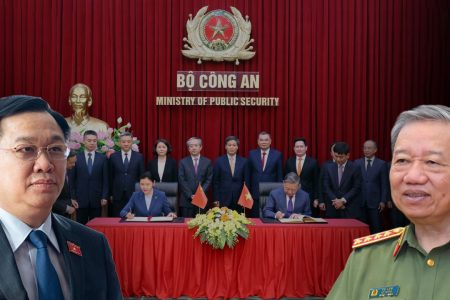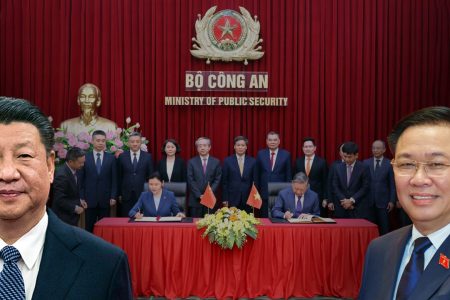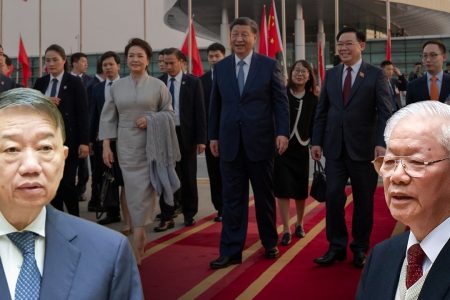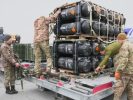
Chinese state media reported on March 12 that its army had expeled a US warship out of the waters near the Hoang Sa (Paracels) that Beijing occupies in the East Sea (South China Sea), and called the US action a showing power to gain influence the region.
China Daily reported that Colonel Li Huamin, spokesman of the Southern Command, the People’s Army of China said that the USS McCampbell with guided missile of the US Navy had entered Chinese waters on March 11 without permission. The Chinese military has mobilized the navy and air force to closely follow US ships, warning and chasing American ships out of the area.
“China has undisputed sovereignty over the Hoang Sa in the South China Sea and surrounding waters. The Chinese military maintains high vigilance at all times and will take necessary measures resolutely to protect sovereignty, peace and stability in the South China Sea,” said Spokesman Li Huamin.
The Communist Party’s Global Times, citing a Chinese naval expert Li Jie, said the United States is seeing the South China Sea as the main battleground against China and will increase its future activities because the US is increasingly losing its influence in the South China Sea.
The Chinese newspaper also said that in late January, China chased another US warship, Montgomery, from the waters near the disputed Truong Sa (Spratlys).
On February 29, 2020, the U.S. Navy said that a Chinese Navy destroyer fired a laser at an American patrol plane while the plane flew across the Philippine Sea, off Guam Island. about 600 km to the west.

The US Pacific Fleet said in a statement that a Chinese ship fired lasers onto US P-8A Poseidon aircraft “unsafe” and “unprofessional,” while the P- 8 is operating “in international airspace in accordance with international laws and regulations.”
The U.S. Navy said China’s actions violated the Code of Unplanned Encounter at Sea (CUES), a multilateral agreement reached in 2014, and also inconsistent with the Memorandum of Understanding (MOU) between the US Department of Defense and China’s Ministry of Defense on the safety of air and sea encounters.
In response to Chinese media reports saying that they fired a laser at a US reconnaissance plane last month was “not true“.
China’s Defense Ministry said on February 17, a US P-8 patrol plane ignored the warnings and acted dangerous to personnel on both sides while Chinese vessels were in progress. a routine naval exercise. The statement, posted on Wechat’s account by Spokesman Ren Qiangqiang, said all Chinese actions in the event were safe, professional and in compliance with international law, but provided no further information. detail.
On March 5, 2020, China published a report saying that more than 300 Vietnamese fishing vessels invaded China’s territorial waters.
A report by the South China Sea Strategic Situation Research Initiative (SCSPI) at Peking University, China, published by the Chinese media on March 5 said there were a total of 311 Vietnamese fishing vessels intruding China’s inland, territorial waters and exclusive economic zone in February, for the purpose of fishing and spying illegally.
“Of these, 212 ships entered the southeastern waters of Hainan Island, the Leizhou Peninsula and the waters near Guangdong, and about 90 fishing vessels entered China’s territorial waters in the Gulf of Tonkin,” Chinese report says.
According to the report, most of Vietnam’s fishing vessels are concentrated in areas near major waterways for the country’s naval and air forces in the two provinces. “Some Vietnamese fishing vessels are even within the reach of Chinese military bases,” the report added.
“The operation of these ships is for two purposes only: One is an economic purpose, ie illegal fishing. The second is the purpose of military security, that is, performing reconnaissance and espionage activities,” the report of the China Research Institute said.
The event when China published a report on the action of “300 Vietnamese fishing vessels invading territorial waters” at the time the US aircraft carrier USS Theodore Roosevelt arrived in Da Nang was “calculated” and “intentional“, said Dr. Ha Hoang Hop, a researcher at ISEAS institute Yusof Ishak, based in Singapore.

The Chinese report said the activity of Vietnamese fishing vessels with intrusive activity in February has increased at least twice as much as the previous month.
“Compared to Vietnam’s activities in the disputed waters in the South China Sea, the nature of these activities is even worse. It completely violates China’s sovereignty and security, ”concluded the Chinese report.
Dr. Ha Hoang Hop said: “The border is in the Tonkin Gulf, this agreement was signed in advance and the two sides have complied, that is, they have drawn a line at sea, this side is from China and the other side belongs to Vietnam, because there are continental shelves connected, and Hainan Island also has a continental shelf. “
He said: “A week ago, the Chinese took more than 140 ships to Thi Tu Island, which Filipinos now manage. And now, China is having hundreds of ships in the Hoang Sa, mostly naval vessels, maritime vessels, and they now drive all Vietnamese fishing vessels out of there. Such a move is in response to American ships visiting Vietnam’s Tien Sa port.”
On March 2, Philippine Daily Inquirer newspaper quoted Vice Admiral Rene Medina, commander of the Philippines Army Command (Wescom) said that they had tracked 136 Chinese fishing boats near Thi Tu Island from January 1 to February 25. Wescom also discovered two Chinese maritime vessels and a Chinese naval ship that appeared in February.
The record frequency of maritime patrols in the East Sea throughout 2019 shows that “the United States fiercely challenges China’s claims in the East Sea,” is a statement of US radio station VOA on Feb 7.
In 2019, the U.S. Navy conducted seven maritime patrols under the Freedom of Navigation Operation (FONOP), more than any other year since 2015, when the US began to challenge stronger China’s claims.
The U.S. Pacific Fleet provided the figures, stating that FONOP patrols were designed to challenge Chinese claims to maritime and territorial sovereignty over many of the region’s archipelagos, putting the US and its allies at odds with Beijing.
The U.S. defense news website states that during these maritime patrols, US warships entered waters within 12 nautical miles of the islands claimed by China, including disputed entities Beijing transformed into a military bases.
According to Defense news, FONOP patrols are a sign to China that the US considers China’s claims in the East Sea as “excessive.” Beijing considers that US patrols are frustrating and considers them to be illegal acts, infringing on their waters.
So far, FONOP patrols have not caused China to retract its claims.
In a statement, Pacific Fleet spokesman Rachel McMarr strongly asserted that the US Navy continued to show its determination to challenge China’s “excessive” claims.
“The US regularly conducts patrols to safeguard freedom of navigation around the world,” said Rachel McMarr. All of our operations are designed in accordance with international law and are intended to demonstrate that the US will operate aircraft, boats, and operations wherever international law allows.”
A spokesman for the Pacific Fleet added that maritime patrols are conducted “peacefully and impartially or against any country.”
The first maritime patrol in 2020 was conducted by the US Navy on January 25. Defense News website reported that the USS Montgomery near-shore warship moves near Gac Ma (South Johnson reef) and Đá Chữ Thập (Cross Stones), two Chinese occupied areas in the Truong Sa.
At that time, the Chinese state newspaper said that Beijing had sent two bombers to fly over to threaten the US warship Montgomery.
The US Navy said the FONOP patrol challenged the excessive claims of all regional powers, and the January 25 patrol officially targeted both China, and Taiwan and Vietnam. The US side challenges the notion that it is necessary to inform beforehand “innocent passage” of the seas claimed by other countries.
Trung Nam from Da Nang – Thoibao.de (Translated)




























